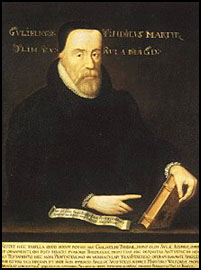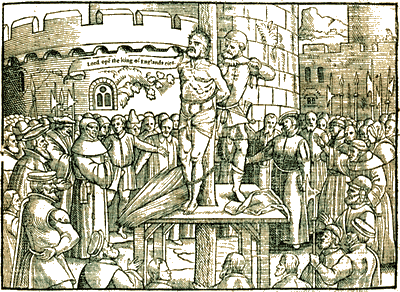|
|
|
|


WILLIAM TYNDALE, translator of the New Testament and Pentateuch, was born on the Welsh border, probably in Gloucestershire, some time between 1490 and 1495. In Easter term 1510 he went to Oxford, where Foxe says he was entered of Magdalen Hall. He took his M.A. degree in 1515 and removed to Cambridge, where Erasmus had helped to establish a reputation for Greek and theology.
Ordained to the priesthood, probably towards the close of 1521, he entered the household of Sir John Walsh, Old Sodbury, Gloucestershire, as chaplain and domestic tutor. Here he lived for two years, using his leisure in preaching in the villages and at Bristol, conduct which brought him into collision with the backward clergy of the district, and led to his being summoned before the chancellor of Worcester (William of Malvern) as a suspected heretic; but he was allowed to depart without receiving censure or giving any undertaking. But the persecution of the clergy led him to seek an antidote for what he regarded as the corruption of the Church, and he resolved to translate the New Testament into the vernacular. In this he hoped to get help from Cuthbert Tunstall, bishop of London, and so "with the good will of his master" he left Gloucester in the summer of 1523. Tunstall disappointed him, so he got employment as a preacher at St Dunstan's-in-the-West, and worked at his translation, living as chaplain in the house of Humphrey Monmouth, an alderman, and forming a firm friendship with John Frith; but finding publication impossible in England, he sailed for Hamburg in May 1524.
After visiting Luther at Wittenberg, he settled with his amanuensis William Roy in Cologne, where he had made some progress in printing a 4to edition of his New Testament, when the work was discovered by John Cochlaeus, dean at Frankfurt, who not only got the senate of Cologne to interdict further printing, but warned Henry VIII and Wolsey to watch the English ports. Tyndale and Roy escaped with their sheets to Worms, where the 8vo edition was completed in 1526. Copies were smuggled into England but were suppressed by the bishops, and William Warham, Archbishop of Canterbury, even bought up copies on the Continent to destroy them. Attempts were made to seize Tyndale at Worms, but he found refuge at Marburg with Philip, landgrave of Hesse. There he probably met Patrick Hamilton, and was joined by John Frith.
About this time he changed his views on the Eucharist and swung clean over from transubstantiation to the advanced Zwinglian position. His Parable of the Wicked Mammon (1528), Obedience of a Christen Man (1528), in which the two great principles of the English Reformation are set out, viz. the authority of Scripture in the Church and the supremacy of the king in the state, and Practyse of Prelates (1530), a strong indictment of the Roman Church and also of Henry VIII's divorce proceedings, were all printed at Marburg. In 1529 on his way to Hamburg he was wrecked on the Dutch coast, and lost his newly completed translation of Deuteronomy. Later in the year he went to Antwerp where he conducted his share of the classic controversy with Sir Thomas More.
After Henry VIII's change of attitude towards Rome, Stephen Vaughan, the English envoy to the Netherlands,
suggested Tyndale's return, but the reformer feared ecclesiastical hostility and declined. Henry then demanded his surrender from the emperor as one who was spreading sedition in England, and Tyndale left Antwerp for two years, returning in 1533 and busying himself with revising his translations. In May 1535 he was betrayed by Henry Phillips, to whom he had shown much kindness as a professing student of the new faith. The imperial officers imprisoned him at Vilvorde Castle, the state prison, 6 mi. from Brussels, where in spite of the great efforts of the English merchants and the appeal of Thomas Cromwell to Archbishop Carandolet, president of the council, and to the governor of the castle, he was tried for heresy and condemned. On the 6th of August 1536 he was strangled at the stake and his body afterwards burnt.

The Burning of William Tyndale, from Foxe's Book of Martyrs
Though long an exile from his native land, Tyndale was one of the greatest forces of the English Reformation. His writings show sound scholarship and high literary power, while they helped to shape the thought of the Puritan party in England. His translation of the Bible was so sure and happy that it formed the basis of subsequent renderings, especially that of the authorized version of 1611. Besides the New Testament, the Pentateuch and Jonah, it is believed that he finished in prison the section of the Old Testament extending from Joshua to Chronicles. Beside the works already named Tyndale wrote A Prologue on the Epistle to the Romans (1526), An Exposition of the 1st Epistle of John (1531), An Exposition of Matthew v.-vii. (1532), a Treatise on the Sacraments (1533), and possibly another (no longer extant) on matrimony (1529).
Excerpted from:
Encyclopedia Britannica, 11th Ed., vol. XXVII.
Cambridge: Cambridge University Press, 1910. 499.
 | to William Tyndale |
Site copyright ©1996-2018 Anniina Jokinen. All Rights Reserved.
Created by Anniina Jokinen on September 14, 2006. Last updated December 15, 2018.
|
|
The Tudors
King Henry VII
Elizabeth of York
King Henry VIII
Queen Catherine of Aragon
Queen Anne Boleyn
Queen Jane Seymour
Queen Anne of Cleves
Queen Catherine Howard
Queen Katherine Parr
King Edward VI
Lady Jane Grey
Queen Mary I
Queen Elizabeth I
Renaissance English Writers
Bishop John Fisher
William Tyndale
Sir Thomas More
John Heywood
Thomas Sackville
John Bale
Nicholas Udall
John Skelton
Sir Thomas Wyatt
Henry Howard
Hugh Latimer
Thomas Cranmer
Roger Ascham
Sir Thomas Hoby
John Foxe
George Gascoigne
John Lyly
Thomas Nashe
Sir Philip Sidney
Edmund Spenser
Richard Hooker
Robert Southwell
Robert Greene
George Peele
Thomas Kyd
Edward de Vere
Christopher Marlowe
Anthony Munday
Sir Walter Ralegh
Thomas Hariot
Thomas Campion
Mary Sidney Herbert
Sir John Davies
Samuel Daniel
Michael Drayton
Fulke Greville
Emilia Lanyer
William Shakespeare
Persons of Interest
Visit Encyclopedia
Historical Events
Field of the Cloth of Gold, 1520
Pilgrimage of Grace, 1536
The Babington Plot, 1586
The Spanish Armada, 1588
Elizabethan Theatre
See section
English Renaissance Drama
Images of London:
London in the time of Henry VII. MS. Roy. 16 F. ii.
London, 1510, the earliest view in print
Map of England from Saxton's Descriptio Angliae, 1579
Location Map of Elizabethan London
Plan of the Bankside, Southwark, in Shakespeare's time
Detail of Norden's Map of the Bankside, 1593
Bull and Bear Baiting Rings from the Agas Map (1569-1590, pub. 1631)
Sketch of the Swan Theatre, c. 1596
Westminster in the Seventeenth Century, by Hollar
Visscher's Panoramic View of London, 1616. COLOR
|
|